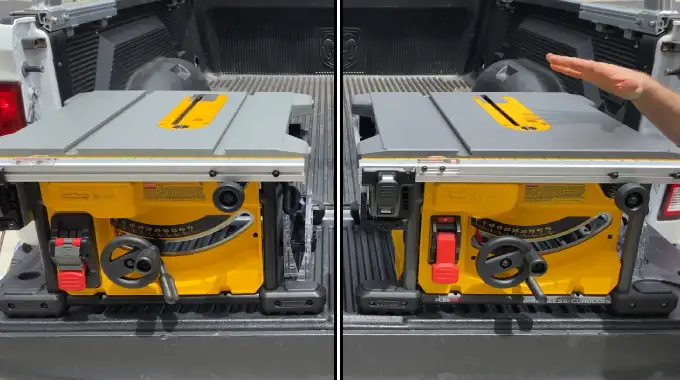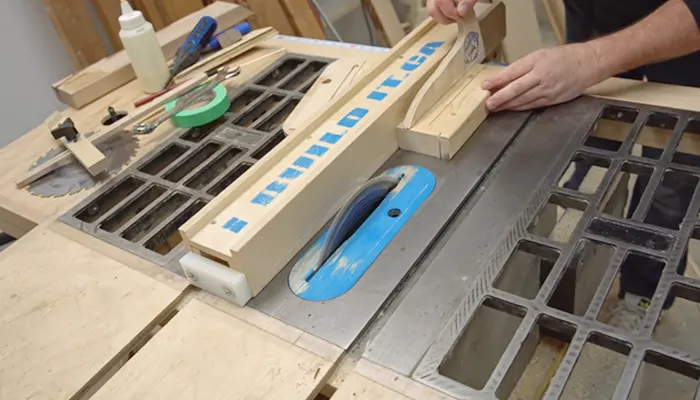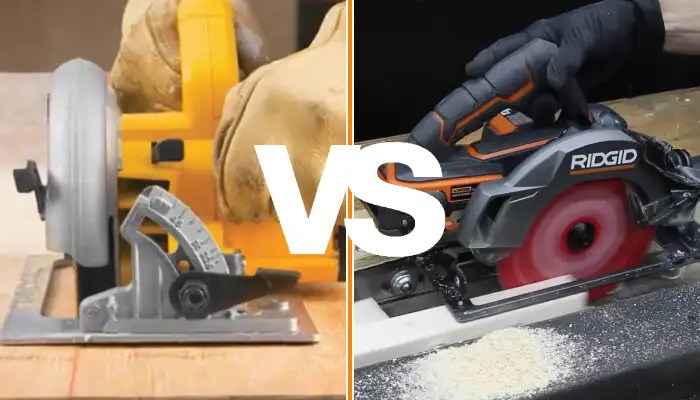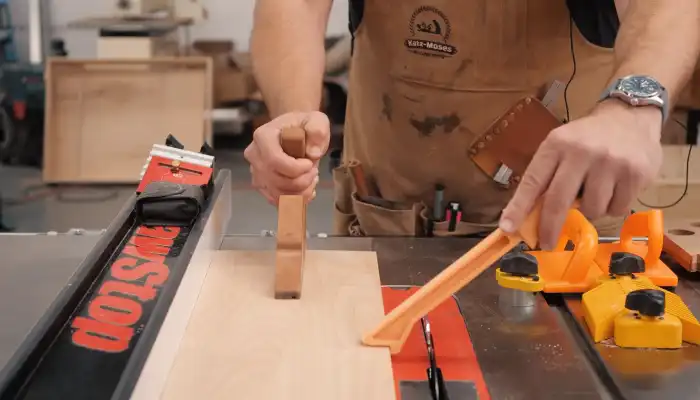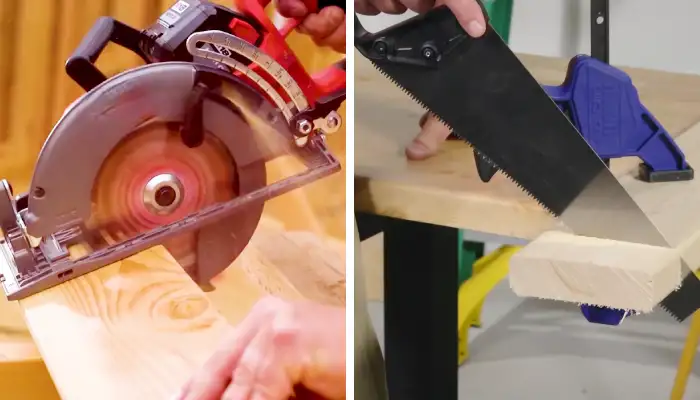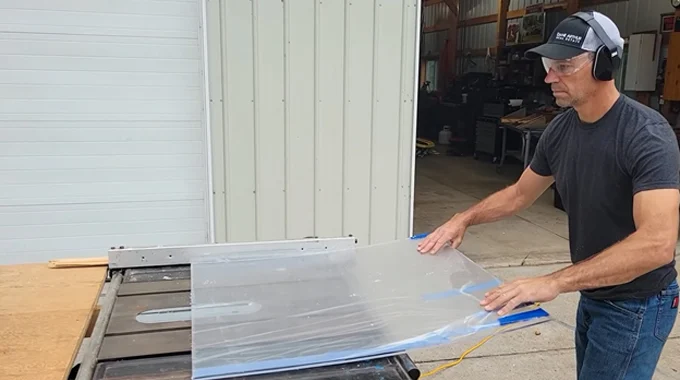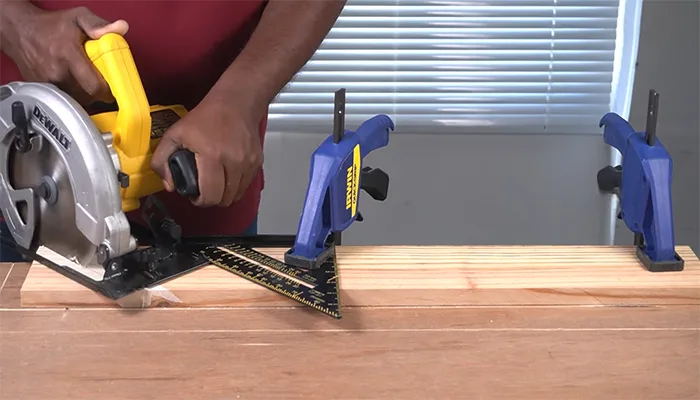Corded vs Cordless Table Saw: 6 Key Differences
Table saws have revolutionized woodworking, making it easier, faster, and more accurate. As far as table saws go, you can find two main types: corded and cordless table saws. Each type has its benefits and drawbacks, so knowing their differences can help you choose the right tool for your job.
According to my research, corded and cordless table saws differ in their power output, where I found that corded saws generally offer higher power output than cordless ones.
Regarding material and build, corded table saws often feature robust materials in their construction. On the other hand, cordless table saws are designed with a focus on portability and often incorporate lightweight materials while maintaining durability.
I will discuss all the differences between corded and cordless table saws to help you decide your purchase.
- Compact Design for Easy Storage
- Precision Rack and Pinion Adjustments
- Professional 24.5″ Rip Capacity
- Site-Pro Modular Guarding System
- Power-Loss Reset for Safety
- Impressive 24.5 ft. Rip Capacity
- Convenient On-Board Storage
- Effortless Tool-Free Changes
- Versatile Battery Compatibility
- Powerful Brushless Motor Technology
6 Differences Between Corded and Cordless Table Saw
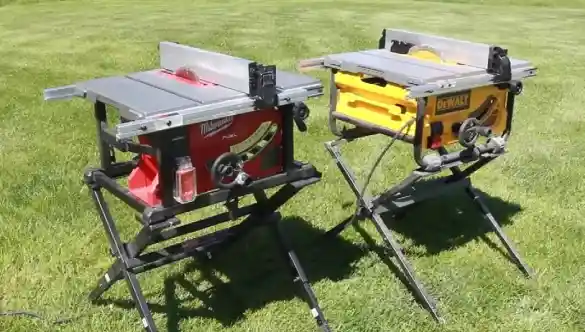
There are notable distinctions between corded and cordless table saws, each catering to specific needs and preferences in woodworking.
- Power output
- Material and build
- Weight and portability
- Intended use and project considerations
- Noise level
- Maintenance requirements
Check out each key difference between corded and cordless table saws to determine which is best for you based on your woodworking needs and preferences.
1. Power Output
In my exploration of the disparities between corded and cordless table saws, a distinct differentiation became apparent, particularly regarding their power output.
Corded table saws offer higher power output, typically ranging from 13 to 15 amps. This high power output makes them well-suited for heavy-duty tasks, as they can efficiently cut through tough materials. The power provided by corded saws is consistent, ensuring reliable performance.
Conversely, cordless table saws have a power output that varies within a certain range. They typically operate in the range of 18 to 60 volts, with higher voltages corresponding to higher power output.
While cordless saws provide ample power for many applications, they may face limitations when dealing with exceptionally hard or thick materials. You should consider the power output when choosing between a corded and cordless table saw based on the specific requirements of your projects.
2. Material and Build
Corded table saws prioritize durability and stability, employing robust materials such as steel and cast iron for their construction. Steel is utilized for the frame, supports, and other structural components, providing strength and rigidity.
Cast iron, on the other hand, is found in the table surface and critical parts, enhancing stability and dampening vibrations. Aluminum alloy may also be incorporated in certain components to balance strength and weight.
In contrast, cordless table saws focus on portability, employing lightweight materials like lightweight alloys for the frame and components.
Plastic is used for casings, guards, and non-structural parts to reduce overall weight, while composite materials compromise strength and weight. Rubberized grips and handles are added for ergonomic design and user comfort during operation.
3. Weight and Portability
Regarding portability and weight, there are significant differences between corded and cordless table saws. Corded saws are often heavier than cordless saws, making them less maneuverable and more challenging to transport. They can be quite hefty, ranging from approximately 150 to 220 pounds.
Furthermore, corded saws are inherently less portable than cordless models, which can be limiting for those who require movement around their workshop or job site. They are designed for use in a fixed location and rely on a power outlet to operate, restricting mobility and convenience.
On the other hand, cordless saws are designed to be lightweight and more ergonomically designed, making them easy to handle and maneuver around job sites or workshops.
They typically weigh between 40-50 pounds, making them highly portable and convenient. Additionally, as they operate on rechargeable batteries, they allow you to work anywhere without being constrained by the need for electricity.
4. Intended Use and Project Considerations
Corded table saws are designed for heavy-duty tasks and prolonged use, making them the preferred choice for professional woodworkers or those working on large projects. With a constant power supply, they provide consistent performance and can handle cutting through thick materials with ease.
Meanwhile, cordless table saws are more suitable for smaller projects and situations that require frequent mobility or lack of access to a power outlet. While they may not offer the same power level as corded saws, they excel in portability and convenience. DIY enthusiasts and those who prioritize mobility will find cordless table saws their go-to option.
5. Noise Level
Corded saws have the potential to generate more noise, especially if they have powerful motors. This can be a concern for users who work in noise-sensitive environments.
Conversely, cordless saws, often equipped with brushless motors, tend to produce less noise. This can benefit those working in residential areas or places where noise levels need to be minimized.
The reduced noise level of cordless saws can provide a quieter working environment, allowing for better concentration and reduced disturbance to others nearby.
6. Maintenance Requirements

Corded table saws generally have simpler maintenance needs since they don’t rely on batteries. Regular checks on the power cord and motor components are essential to ensure safe and efficient operation.
Inspecting the power cord for any signs of wear or damage is crucial to prevent electrical hazards. Additionally, keeping the motor clean and free from dust and debris is important for optimal performance.
On the other hand, cordless table saws require additional attention to battery maintenance. Users need to monitor battery health, recharge as needed, and consider replacing batteries over time. Proper storage and handling are also necessary to prolong their lifespan.
Corded and Cordless Table Saw Comparison Chart
| Aspects | Corded Table Saw | Cordless Table Saw |
| Power Output | 13-15 amps, consistent for heavy-duty tasks | 18-60 volts, variable power; suitable for many applications |
| Material and Build | Steel and cast iron for durability | Lightweight alloys and plastics for portability |
| Weight and Portability | Heavier (150-220 lbs), less portable | Lighter (40-50 lbs), highly portable, operates cordlessly |
| Intended Use | Heavy-duty tasks, professional use | Smaller projects, DIY, mobility-focused |
| Noise Level | Potentially louder due to powerful motors | Quieter, especially with brushless motors |
| Maintenance Requirements | Simple maintenance (cord, motor) | Battery monitoring, recharging, and storage considerations |
What gauge of wire is required for a corded table saw?
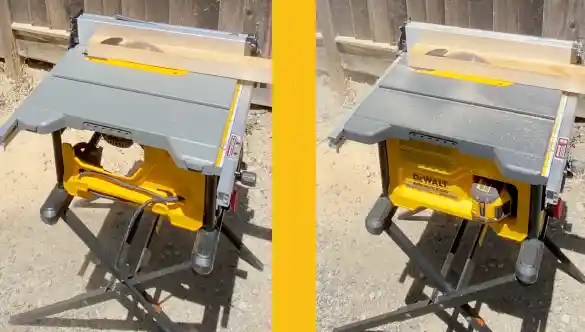
To ensure optimal performance, always use a wire gauge that accommodates both the running load and startup amps when operating a corded table saw. A 12-gauge extension cord is suitable for the running load, but it may restrict the amps during startup, especially with longer lengths.
If you want a smoother startup and minimize current flow restrictions, consider upgrading to a 10-gauge cord. This will allow for a more efficient power draw and prevent limitations during startup.
It’s also important to keep the cord as short as possible to optimize performance. Using the appropriate wire gauge ensures that your corded table saw operates efficiently and effectively without encountering any power limitations.
Can you utilize higher voltage batteries to enhance the power of a cordless table saw?
The use of higher voltage batteries is not recommended for cordless table saws. It’s crucial to follow the manufacturer’s specifications regarding battery voltage to ensure proper and safe operation of the tool.
Introducing batteries with a higher voltage than recommended can result in overheating, potential damage to the saw, and safety hazards. Sticking to the specified battery voltage is essential to maintain the saw’s performance and longevity while avoiding risks associated with incompatible power sources.
Choose a Cordless or Corded Table Saw According to Your Woodworking Needs
In the competitive table saw market, corded and cordless variants each bring distinct strengths and weaknesses to the woodworking landscape. Your choice between the two ultimately hinges on your individual requirements and preferences.
My research findings indicate that a corded saw is the best choice for heavy-duty work because it offers consistent power and durability. Conversely, if portability, convenience, and mobility are key considerations for smaller projects, a cordless saw could be the perfect fit for you.
Whether you’re a professional woodworker or a DIY enthusiast, knowing these differences will help you to make the best choice that aligns with your needs.
- Worm Drive Power for Maximum Torque
- Precision Rack and Pinion System
- Compact and Lightweight Design
- 2-5/8 Inch Depth of Cut
- Patented Dual-Field Motor for Durability
- Cordless Portability with Corded Power
- BITURBO Brushless Technology
- Large 25″ Ripping Capacity
- Smart Guard System for Safety
- Transportable Single-Handed Design
Last update on 2025-12-21 / Affiliate links / Images from Amazon Product Advertising API

